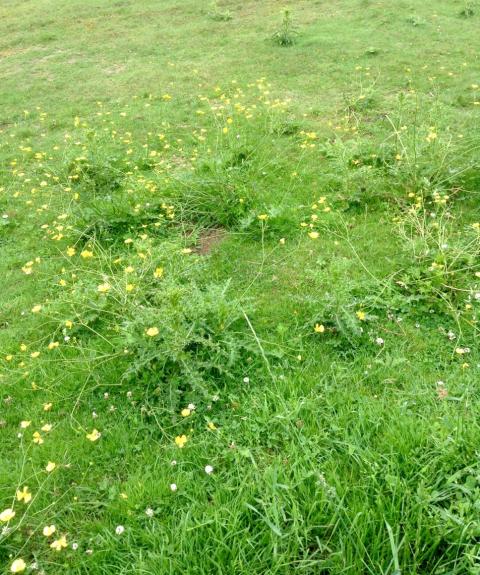Notes on Walking Through a Pasture

Walking through what a client called a “pasture with problems”, I was able to identify a lot of issues that needed to be addressed, but also some positive things. Some of the areas in need of improvement included:
A scattering of fairly tall, stand-alone plants - There are a few possible suspects. Dock is one, and I see too much of it in wet hay meadows. However, if you get up close - mind you, not too close - I think you’ll see bull thistle. A biennial, this one is now forming flower clusters. That means it was there last year in its vegetative stage. It then wintered over as a close to the ground spiky rosette. Another name for it is ‘Spear Thistle’, and your livestock will give it a wide berth as it goes to seed.
Patchy, close-cropped survival grasses, bare sandy soil - Which implies over-grazing, either from a lack of quality forage and/or over-stocking of animals on pasture. Common especially on horse pastures that are expected to serve as both forage and exercise yards. Hard to do both, torn up sod and exposed, compacted soils are usually a consequence.
Buttercups in flower - Yes they do have toxic properties, although reportedly not so in dry hay. Generally distasteful to livestock, thankfully. I’ve seen cows in overgrazed pastures with head-high, but seemingly ignored, buttercups. These are rather healthy looking perennial plants -been there sometime- and will set plenty of seed… which will like those bare soil patches. Its generic “Latin Name” Ranunculus meaning “little frog” tells you about buttercup’s moist soil preference. All too abundant on fields in need of drainage work.
More Thistles! - These, however, are the perennial Canada thistle. Not as tall growing, or vigorous appearing as the Bull Thistle but a definite problem. That’s because of their extensive underground rhizomes pops up new plants anywhere it can. The picture illustrates this well, with various size thistle plants that livestock avoid, and the weed patch grows ever larger.
…now for the more optimistic outlook:
White Clover – An important forage legume that is able to withstand close grazing because of its close-to-the-ground growth habit. Here it shows up nearby the thistles and buttercups, which probably render it some protection. Having a shallow root system it may also benefit from the moist soils I suspect are present.
Thick patch of grass – Why here? My guess is it overlays a manure pat, or perhaps some spilled fertilizer. I didn’t dig down at the time to be sure. The point is, here is an example of what’s possible, given improved management. Grass is very aggressive and with the proper pH, adequate nutrients, especially nitrogen and potassium, (possibly phosphorus if it hasn’t been manured) it will be a match for most weeds. Giving it time to regrow/rejuvenate itself between grazings is of course, essential. This particular species is likely Kentucky Bluegrass, which, like White Clover is able to tolerate close grazing. They are frequently found together in intensive pasture systems.
Seed heads of Perennial Ryegrass – Almost missed these, I think of them more as a nurse plant included in the seed mix to give you a quick cover. When erosion, or weeds infestation is a possibility it gives the more desirable, long-term grass types time to establish. Although a good clump forming forage grass, they aren’t very hardy, and seldom survive many New Hampshire winters.
Having identified both challenges and opportunities, where do you go from here?
It’s always worth starting with a soil test to know just where you stand. The UNH test will give you the level of the pH and key plant nutrients with a recommendation of what needs to be applied for your particular crop. In addition you should also obtain a soils map of you field either directly from the local NRCS/USDA office or thru their “Web-Soil Survey” on the internet. This will alert you to the field’s physical soil characteristics (i.e. shallow bedrock, poor drainage) which impact crop growing decisions. These are typically more difficult to resolve than fertility issues.
Since there looks to be some grasses and clovers present, let’s start by getting the pH at the right range to benefit both grasses and clovers, say 6.5 pH. Lime and wood ash applications can both serve this purpose. Then, fertilize based on your soil test results. On pastures, for more efficient use of the nitrogen fertilizer, split the total application timed to the needs of the grass. Perhaps try about two-thirds as it starts to green-up in spring, the remainder after first grazing.
At the same time, rotate the livestock to an alternate field/paddock following first grazing. This gives the grass time to recover and produce new, vigorous growth…which also makes it more competitive to encroaching weeds. Move your cattle off when it’s about 4 inches high – it varies by grass types, but that’s a good starting point. This is now your chance to evaluate the pasture’s overall condition:
What weeds are present, and are you better off getting rid of them by clipping or by spraying? Any bare spots that need to be filled in? Early August is a nice time for that as soils are warmer, meaning quicker seed germination, while also trending to the cool, moist conditions that grasses prefer. If you don’t get to it then, a later ‘Frost seeding’ with clover is another possibility. Manure pats? Think of them as concentrated fertilizer… break them up and spread it over the field. Consider the picture included. If left intact will the livestock just eat around it, letting weeds flourish in that choice spot? Fly and parasite control is another benefit to dragging and chain-harrowing these manure piles.
